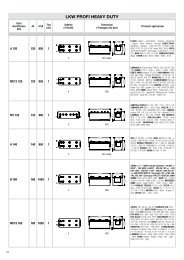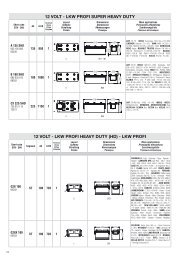Friendly Power
Friendly Power
Friendly Power
You also want an ePaper? Increase the reach of your titles
YUMPU automatically turns print PDFs into web optimized ePapers that Google loves.
general InstructIons for use, charge and InstallatIon of the battery<br />
storm<br />
INSTRUCTIONS FOR USE<br />
Storm series batteries are sealed and can be installed in various positions.<br />
They do not require any special maintenance interventions.<br />
ACTIVATION<br />
The battery must be activated using the supplied acid. The acid is furnished<br />
separate from the battery in order to ensure a longer working life.<br />
The battery’s life cycle begins from its time of activation.<br />
Follow the activation procedure illustrated below:<br />
Only use the supplied acid. Position the battery on a horizontal surface<br />
and remove the protective foil (fig. 1). Never activate the battery while it<br />
is in the vehicle’s battery compartment. Manually remove the protective<br />
film from the acid (fig. 2). Remove the cap and set it aside (fig. 3). Do not<br />
puncture the acid container (fig. 4). Overturn the acid container vertically<br />
(fig. 5) and press it against the battery. The seals will break and the acid<br />
will begin to flow (fig. 6). Check whether or not bubbles are present,<br />
indicating the acid is flowing out of the container.<br />
Leave the container in this vertical position for at least 20 minutes (fig. 6).<br />
If no bubbles appear, tap the container lightly with your hand to get the<br />
acid flowing. Whatever the case, do not remove the acid container until<br />
it is completely empty. Once the acid has drained completely, tap the<br />
container lightly to expel any remaining acid and carefully remove the<br />
container (fig. 7). Use the caps of the acid containers to seal the holes<br />
in the battery (fig. 8). Press the caps down on each of the holes until<br />
they are level with the battery’s casing (fig. 9). Do not remove the cap<br />
under any circumstances.<br />
Charging<br />
After having been activated, the battery is ready for use. Proceed with<br />
the installation of the battery upon the vehicle. In rare circumstances,<br />
the battery’s charge voltage may be less than 12.60 V. In such cases, it<br />
will need to be charged. Connect the positive terminal first (fig. 9) according to the battery’s polarity diagram (varies based on the<br />
model). Do not exceed the specified maximum current values, nor the 24 hours of charging time. If using a battery charger, refer to<br />
its relative instruction manual. The battery can be charged in either of the following manners:<br />
a) Constant voltage charging 14.4-15V for 6 to 24 hours<br />
b) Constant current charging use a constant charging current equal to 1/10 of the rated capacity (for example, for a battery with a rated<br />
capacity of 10 Ah, the charging current should be 1A). Recommended charging time: 5 to 8 hours. If you have any doubts regarding<br />
the battery charging method, contact a specialist. The battery is fully charged once the voltage level has reached at least 12.60V.<br />
INSTALLATION ANd CONNECTION<br />
Clean and dry the battery. Shut off the engine and all of the instruments. Remove the keys from the ignition. Place the battery in<br />
the battery compartment. Clean and lightly grease the contacts and terminals. Refer to the vehicle’s instruction manual. Make sure<br />
that the battery is properly connected to the electrical system and that all of its fastening screws have been properly tightened.<br />
Ignition<br />
Start the engine. Let the starter turn for 5 seconds. If the engine does not start immediately, wait 10 seconds and try again.<br />
REMOVAL<br />
Refer to the vehicle’s instruction manual. Disconnect the negative terminal first.<br />
Prolonged disuse of the vehicle<br />
If the vehicle is not going to be used for more than 3 months, recharge the battery and disconnect its negative terminal from the<br />
vehicle’s electrical system. This will prevent the battery from discharging completely. Periodically check the battery’s charge.<br />
ACCIdENTAL dISCHARGE<br />
Avoid discharging the battery completely. This could cause irreversible damage to a number of its components. Recharge the battery<br />
as soon as any of the signs indicated in the “Charging” section are encountered.<br />
49







